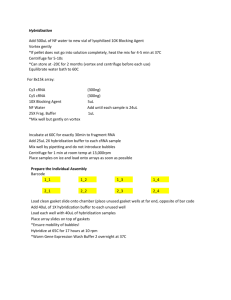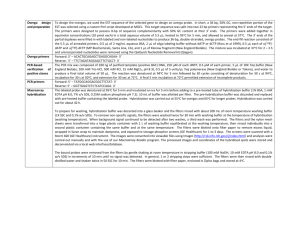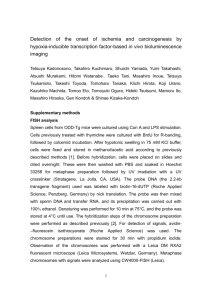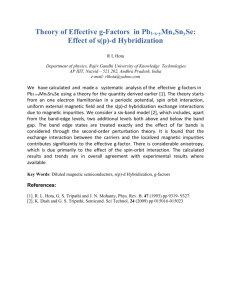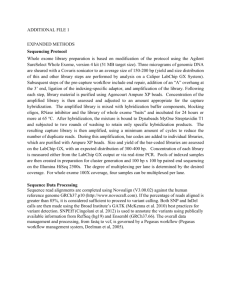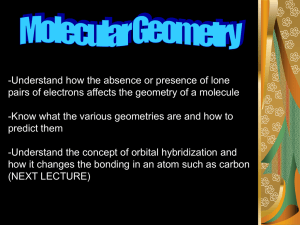MS Word - Human Genome Transcript Mapping
advertisement
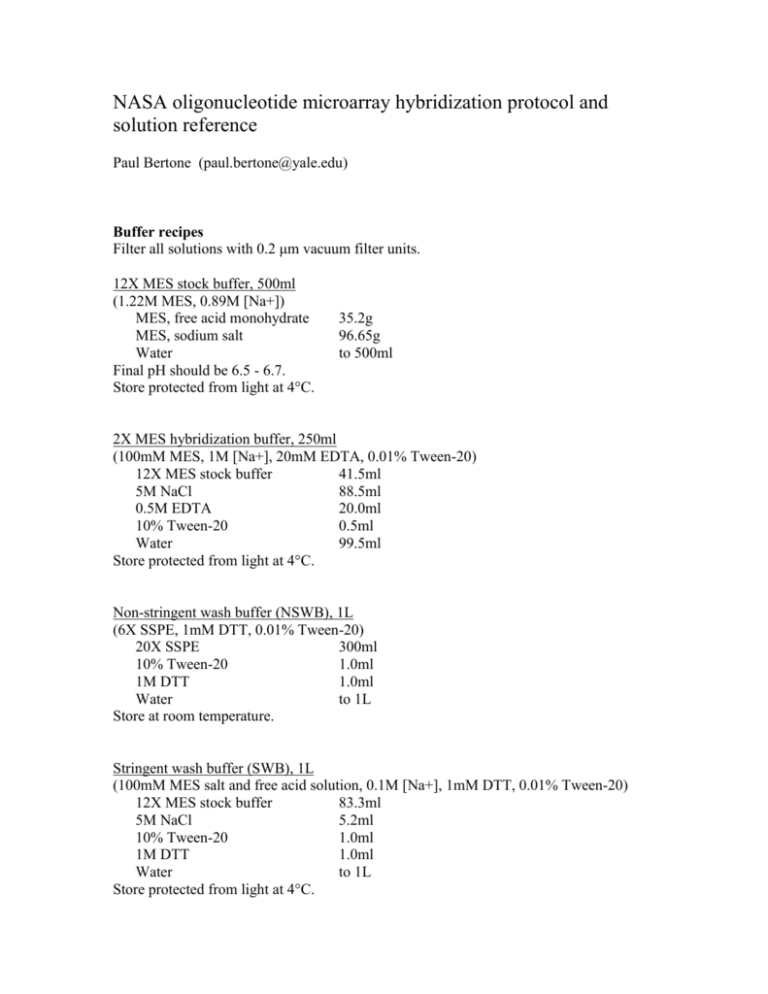
NASA oligonucleotide microarray hybridization protocol and solution reference Paul Bertone (paul.bertone@yale.edu) Buffer recipes Filter all solutions with 0.2 μm vacuum filter units. 12X MES stock buffer, 500ml (1.22M MES, 0.89M [Na+]) MES, free acid monohydrate MES, sodium salt Water Final pH should be 6.5 - 6.7. Store protected from light at 4°C. 35.2g 96.65g to 500ml 2X MES hybridization buffer, 250ml (100mM MES, 1M [Na+], 20mM EDTA, 0.01% Tween-20) 12X MES stock buffer 41.5ml 5M NaCl 88.5ml 0.5M EDTA 20.0ml 10% Tween-20 0.5ml Water 99.5ml Store protected from light at 4°C. Non-stringent wash buffer (NSWB), 1L (6X SSPE, 1mM DTT, 0.01% Tween-20) 20X SSPE 300ml 10% Tween-20 1.0ml 1M DTT 1.0ml Water to 1L Store at room temperature. Stringent wash buffer (SWB), 1L (100mM MES salt and free acid solution, 0.1M [Na+], 1mM DTT, 0.01% Tween-20) 12X MES stock buffer 83.3ml 5M NaCl 5.2ml 10% Tween-20 1.0ml 1M DTT 1.0ml Water to 1L Store protected from light at 4°C. 20X SSPE, 1L Combine: NaCl 175.3g NaH2PO4-H2O 27.6g EDTA 7.4g in 800ml distilled water Boil until salt is fully dissolved. Adjust the pH to 7.4 with 10M NaOH. Adjust the volume to 1L with distilled water. 20X SSC, 1L Combine: NaCl 175.3g Sodium citrate 88.2g in 800ml distilled water Boil until salt is fully dissolved. Adjust the pH to 7.0 with 1M HCl. Adjust the volume to 1L with distilled water. Hybridization solutions Volumes appropriate for hybridizations in Secure-Seal adhesive modules (Grace BioLabs SA-200, adhesive seal tabs ST-200) Pre-hybridization solution, 400ul 2X MES hybridization buffer Nuclease-free water Herring or salmon sperm DNA, 10mg/ml BSA, 50mg/ml 200µl 192µl 4µl 4µl Hybridization solution, 320ul 2X MES hybridization buffer 160µl Cot-1 DNA, 1mg/ml 30µl BSA, 50mg/ml 3µl Labeled control oligo, 100nM 3µl (multiple channel experiments require additional control oligos) Labeled cDNA probe >= 2µg/sample Water to 320µl Volumes appropriate for hybridizations using standard coverslips and HybChambers (Gene Machines HYB-03 or HYB-04) Pre-hybridization solution, 300ul 2X MES hybridization buffer Nuclease-free water Herring or salmon sperm DNA, 10mg/ml BSA, 50mg/ml 100µl 198µl 1µl 1µl Hybridization solution, 40ul 2X MES hybridization buffer 20µl Herring or salmon sperm DNA, 10mg/ml 0.4µl BSA, 50 mg/ml 0.4µl Labeled control oligo, 100nM 0.4µl (multiple channel experiments require additional control oligos) Labeled cDNA probe >= 2µg/sample Nuclease-free water to 40µl References to water = Millipore or nuclease-free water. Do not use DEPC-treated water. Control oligos Each microarray is designed to include a number of control features complementary to a common DNA sequence. When the arrays are hybridized, an end-labeled 24mer oligo is used to illuminate these features, forming a grid to which the scanned image will be aligned in software. An appropriate concentration of this control oligo must be spiked into the hybridization solution and should fluoresce in the same emission spectrum as the labeled DNA probe. Thus, a two-channel experiment must include two control oligos, each fluorescence-labeled to coincide with the excitation and emission spectra used for the two experimental samples. Fluor-5’ TTCCTCTCGCTGTAATGACCTCTA 3’ Hybridization protocol (for Secure-Seal gasket hybridization modules) 1. 2. 3. 4. 5. 6. Pipette 400µl of pre-hyb solution into hybridization module and incubate at 45°C for 20 minutes. Remove pre-hyb solution and replace with 320µl hybridization solution. A small air bubble will remain in the module and will agitate the solution during hybridization. Carefully dry both input ports on hybridization module with Kimwipes. This will guarantee complete adhesion of the sealing tabs to the clean surface. Using forceps, apply adhesive tabs to both input ports. The adhesive tabs should be laid completely flat so that a water-tight seal is formed. Insert each array into a 50ml tube covered with aluminum foil. Place tubes into hybridization oven and enable wheel rotation. Incubate for 16-20 hours at 50°C. Following hybridization: 1. 2. 3. 4. 5. 6. 7. 8. 9. 10. Heat SWB to 45°C. Briefly disable the rotating wheel in the hybridization oven, remove one Falcon tube and enable rotation again. It is important to keep the arrays completely hydrated to prevent probe from drying on any part of the printed area. A small volume of liquid will have evaporated during the hybridization cycle, so the arrays should be constantly agitated until the hybridization solution can be removed. Using forceps, carefully remove both adhesive tabs. Minimize the exposure of arrays to ambient light. Remove hybridization solution with 1000µl pipette and immediately replace with 400µl NSWB. Gently pipette up and down 1-2 times and discard NSWB, replacing with a fresh aliquot. Return the array to its original foil-wrapped 50ml tube, oriented horizontally in a tube rack to prevent buffer from leaking out of the module. When all arrays have been processed, remove the adhesive hybridization modules from the slides and place each array into light-tight microscope slide box containing NSWB. Wash in NSWB by agitating on rotating platform for 10 minutes, changing the buffer once. Replace buffer with 45°C SWB. Wash in SWB for 30 minutes, changing the buffer every 5 minutes. Replace buffer with NSWB. Wash in NSWB for 5 minutes, changing the buffer twice. Wash in 0.2X SSC for one minute to remove residual salt from NSWB. Repeat this step for a total of 4 washes. Dry arrays with compressed nitrogen gas. Scan as soon as possible at <= 5 μm resolution. Hybridization protocol (for HybChambers/slide coverslips) 1. 2. 3. 4. Apply pre-hyb solution to arrays and incubate at 45°C for 15 minutes. Remove pre-hyb solution, rinse with distilled water. Apply hybridization solution, place coverslip onto array and seal in HybChamber. Incubate in water bath for 16-20 hours at 50°C. Following hybridization: 1. 2. 3. 4. 5. 6. Heat SWB to 45°C. Remove coverslips and immediately place arrays into light-tight microscope slide box containing NSWB. Wash in NSWB by agitating on rotating platform for 10 minutes, changing the buffer once. Replace buffer with 45°C SWB. Wash in SWB for 30 minutes, changing the buffer every 5 minutes. Replace buffer with NSWB. Wash in NSWB for 5 minutes, changing the buffer twice. Wash in 0.2X SSC for one minute to remove residual salt from NSWB. Repeat this step for a total of 4 washes. Dry arrays with compressed nitrogen gas. Scan as soon as possible at <= 5μm resolution. Equipment and reagents Gene Machines (www.genemachines.com) HYB-04 HybChamber Mica tinted dual microarray hybridization chambers Grace BioLabs (www.gracebio.com) SA-200 Secure-Seal gasketed hybridization chambers ST-200 Adhesive seal tabs Invitrogen (www.invitrogen.com) 15279011 Human Cot-1 DNA Sigma-Aldrich (www.sigmaaldrich.com) 69896 2-Morpholinoethanesulfonic acid sodium salt 69892 4-Morpholineethanesulfonic acid monohydrate
